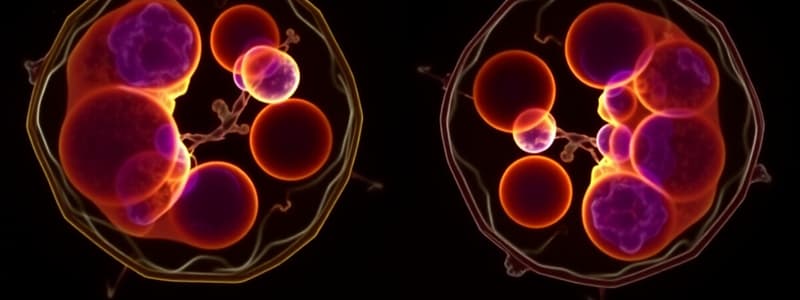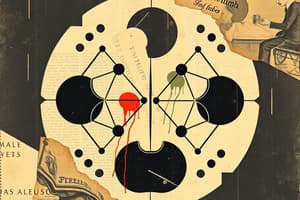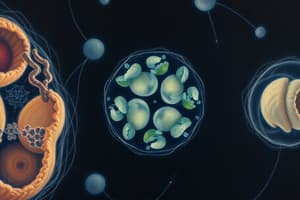Podcast
Questions and Answers
During DNA replication, which enzyme is primarily responsible for unwinding the DNA double helix at the replication fork?
During DNA replication, which enzyme is primarily responsible for unwinding the DNA double helix at the replication fork?
- Helicase (correct)
- Primase
- DNA polymerase
- DNA ligase
A cell is placed in a solution, and it begins to shrink. Which of the following best describes the relationship between the concentration of solutes inside the cell and the concentration of solutes in the surrounding solution?
A cell is placed in a solution, and it begins to shrink. Which of the following best describes the relationship between the concentration of solutes inside the cell and the concentration of solutes in the surrounding solution?
- The solution is hypertonic relative to the cell. (correct)
- The solution and the cell have equal solute concentrations, but the solvent concentration in the solution is lower.
- The solution is hypotonic relative to the cell.
- The solution is isotonic relative to the cell.
Which of the following correctly orders the sequence of events during the cell cycle, starting immediately after cell division?
Which of the following correctly orders the sequence of events during the cell cycle, starting immediately after cell division?
- Interphase, Cytokinesis, Prophase, Metaphase, Anaphase, Telophase
- Interphase, Prophase, Metaphase, Anaphase, Telophase, Cytokinesis (correct)
- Prophase, Metaphase, Anaphase, Telophase, Cytokinesis, Interphase
- Cytokinesis, Prophase, Metaphase, Anaphase, Telophase, Interphase
A protein destined for secretion from a cell interacts with several organelles after translation. Which of the following represents the most likely sequence of these interactions?
A protein destined for secretion from a cell interacts with several organelles after translation. Which of the following represents the most likely sequence of these interactions?
During which transport process does a cell use transport proteins to move substances down their concentration gradient without expending energy?
During which transport process does a cell use transport proteins to move substances down their concentration gradient without expending energy?
Flashcards
What is DNA?
What is DNA?
Double-stranded helix containing genetic information.
What is Replication?
What is Replication?
Process where DNA is copied to produce two identical DNA molecules.
What is Transcription?
What is Transcription?
Process where RNA is synthesized from a DNA template.
What is Translation?
What is Translation?
Signup and view all the flashcards
What is a Codon?
What is a Codon?
Signup and view all the flashcards
Study Notes
- DNA structure involves specific bonds holding it together
DNA Organization
- DNA has multiple levels of organization
Replication, Transcription, Translation
- Replication, transcription, and translation processes produce specific products in particular locations
mRNA Modifications
- There are three types of mRNA modifications
Codons
- Codons are defined by specific functions
Protein-Organelle Interaction
- Proteins interact with organelles once they are made and destined to leave the cell
Mitosis vs. Meiosis
- Mitosis and meiosis are two distinct processes with similarities and differences
Cell Cycle Phases
- The cell cycle includes interphase, prophase, metaphase, anaphase, telophase, and cytokinesis
Cell Theory
- There are three principles of the cell theory
Proliferation, Differentiation, Zygote
- Proliferation, differentiation, and zygote are each distinctly defined
Cellular Organelles
- Cellular organelles include the nucleus, nucleolus, plasma membrane, endoplasmic reticulum, Golgi apparatus, lysosomes, peroxisomes, mitochondria, ribosomes, centrosome, and proteasomes, each with specific functions
Cell External Structures
- Cilia, flagella, and microvilli are structures on a cell's external surface with distinct functions
Passive vs. Active Transport
- Passive and active transport processes have major features that can be compared and contrasted
Passive Transport Examples
- Simple diffusion, facilitated diffusion, and osmosis are three examples of passive transport; each transports different molecules, requires different energy, and moves in relation to concentration gradients
Tonicity
- Hypertonic, isotonic, and hypotonic solutions have different effects on a cell, impacting water movement and cell volume
Exocytosis vs. Endocytosis
- Exocytosis and endocytosis are processes where substances are either released (exocytosis) or brought into the cell (endocytosis)
Studying That Suits You
Use AI to generate personalized quizzes and flashcards to suit your learning preferences.




